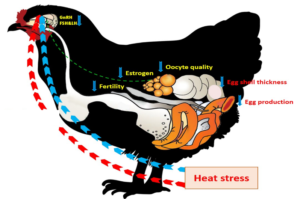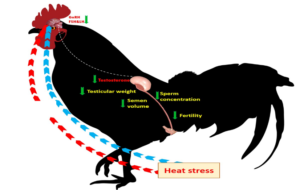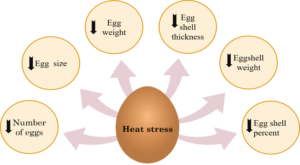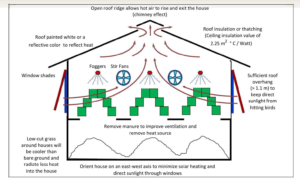CLIMATIC CHALLENGES ON POULTRY PRODUCTION AND ITS AMELIORATION STRATEGIES
- Rajamanickam, P. Visha, S. Alimudeen
Department of Veterinary Physiology and Biochemistry
Veterinary College and Research Institute
Salem, Tamil Nadu
Globally, the poultry industry is gaining significant importance among the agricultural and its allied sectors. However, in the tropical regions, the heat stress has a drastic negative effect on the poultry production. When high temperature is coupled with high humidity, the combination can become critical to birds. Therefore, there is a need to evaluate the management practices employed in poultry farming during hot weather so that heat stress is minimised. Heat stress not only causes suffering and death in the birds, but also results in reduced or production loss that adversely affects the profit from the enterprise.
What is heat stress?
Birds are ‘heat stressed’ if they have difficulty achieving a balance between body heat production and body heat loss. This can occur at all ages and in all types of poultry.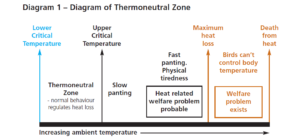
It is important to note that a welfare problem is likely to occur somewhere between the ‘upper critical temperature’ and ‘maximum heat loss’, i.e, before bird losses occur. The farmer should be aware of bird`s behaviour and watch out for signs of distress.
How do birds respond to increasing temperature?
Birds will try to re-establish their heat balance with the surrounding by changing their normal behaviour. Birds may:
- Try to move away from other birds.
- Move towards cooler surfaces, such as the block walls or into moving air streams.
- Lift their wings away from their bodies to reduce insulation and expose any areas of skin that have no feathers.
- Rest to reduce heat generated by activity.
- Reduce feed intake.
- Increase water consumption.
- Divert blood from internal organs to the skin, which darkens skin colour.
- Begin fast panting.
Impact of heat stress on production loss in poultry birds
Heat stress decreases the voluntary feed intake, reduces the growth and average daily weight gain, disturbs the reproductive activities, reduces muscle mass production, causes loss in egg production, increases the disease occurrence by impairing their immune status, lowers the feed conversion ratio, increases egg abnormalities. Heat stress also changes the physiological parameters like increase in rectal temperature, respiration rate and heart rate, increase in H/L ratio, increase in erythrocyte count and decrease in haemoglobin and damage to intestinal mucosa. Immunological changes like decrease in T3, decreased IL-2, decrease in the expression of TLR 7, reduced IgG production and increase in HSP70,.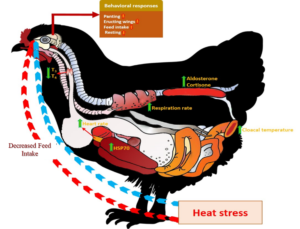
Production loss during heat stress depends on
- Maximum temperature to which the flock was exposed
- Duration of high temperature exposure
- Rate of temperature change
- Relative humidity of air
Impact of heat stress on hen`s reproduction
Heat stress decreases the synthesis and release of reproductive hormones like GnRH, FSH and LH and estrogen. This leads to decreased oocyte quality, fertility, egg shell thickness and egg production.
Heat stress impact of cock fertility
Heat stress decreases the synthesis of male reproductive hormone testosterone, which reduces the fertility by decreasing the testicular weight, sperm concentration and semen volume.
Effect of heat stress on egg production
Increased panting under heat stress conditions leads to increase in CO2 levels and higher blood pH(alkalosis), which in turn:
- hampers the blood bicarbonate availability for egg shell mineralisation
- induces increased organic acid availability.
- decreases free calcium level in the blood in laying hens, as it affects egg shell quality.
Heat stress and meat quality
- Negatively affects fat deposition and meat quality
- Alteration in chemical composition of meat and reduced meat quality in broilers
- Decreased proportion of breast muscle
- Increased proportion of thigh muscle in broilers
- Less protein content
Approaches for heat stress amelioration in poultry
| Approaches for Heat Stress Amelioration in Poultry |
| Nutritional strategies |
| Genetic modifications |
| Management strategies |
| Disease management |
| Feeding time and space |
| Fat supplementation |
| Choice feeding |
| Protein and amino acids levels |
| Electrolytes and vitamins supplementation |
| Vaccination |
| Parasite control |
| Remove sick birds |
| Separating multi-age flocks |
| Water supply |
| Feeding at cooler times of the day
|
| Genetic selection |
| Genetic Marker assisted breeding |
| Disease resistant breed |
| Thermo-tolerant genes |
| Housing strategies |
| Sprinklers |
| Acclimatization |
Genetic approach
Genetic improvement by developing suitable breeding program by incorporating biological markers for heat stress in poultry was considered the best strategy to develop new strains with higher thermo-tolerant ability. Frizzle gene, naked neck gene, dwarf gene, HSP70, and HSP90 are considered reliable biological markers to quantify heat stress response in poultry.
Typical housing management for poultry
To combat the effect of heat stress in poultry farming, the housing pattern for the birds should be made as depicted in the following image.
Nutritional management in poultry
Feeding high energy ration can overcome growth rate depression. High fat content in the feed will lower heat production, improves growth rate and feed utilization. Low protein diet and high ME can improve growth rate and also improves meat yield when supplemented with limiting amino acids-methionine and lysine.
Vitamins are required for maintenance of the performance and immune function. Vitamin C cannot be synthesized during heat stress by birds, so it can be supplemented @ 1000mg/Kg diet which improves heat resistance, carcass quality, reduces mortality and acts as antioxidant and protects against oxidative damage. Vitamin A supplementation @ 8000 IU/Kg diet will alleviate the detrimental effect on egg production during heat stress, improves immunity and protects against oxidative damage. Vitamin E supplementation @ 250mg/Kg diet is beneficial for egg production, increases feed intake, improves egg quality and improves immunity and also act as antioxidant-protects against oxidative damage.
Supplementation of minerals like 1% sodium chloride, 0.15 to 0.6% KCl, 0.2% sodium bicarbonate will improve water consumption, increase tolerance to heat stress and improves production performance. Probiotic supplementation like Lactobacillus strains can enrich micro flora diversity in chicken and reduce harmful effects of heat stress.
Water requirement increases during hot period, 6% increase in water demand occurs per degree increase in UCT, hence 25% more drinking space should be provided. Providing water below their body temperature will aid in heat dissipation.
Conclusions
Given the significance of poultry industry to the Indian economy and the fact that climate change poses serious threat to poultry, efforts are needed to counteract the adverse impact of environmental stress impacting poultry production. Proper nutritional, housing management and disease management strategies that are cost effective needs to be implemented to sustain productive and reproductive performance of poultry under the changing climatic scenario.




